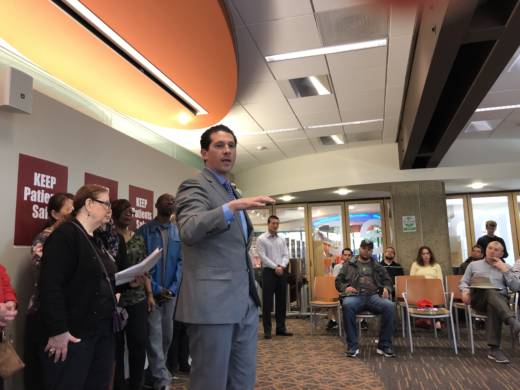“I think it’s a bold measure on the part of the unions to basically force the hospitals to be more transparent about the relationship between their underlying actual costs and their billed prices,” Kominski added.
At a signature-gathering kickoff event in Palo Alto on Saturday, supporters of the measures said they want to make sure that Stanford is not simply hoarding its profits.
“There are workers who are saying, ‘Look, you’re making a huge amount of revenue. So where is that money going to help with patient care? Where is that money going for new technology? Are you reinvesting that?’ ” said San Mateo County Supervisor David Canepa. “What they’re clearly saying is, ‘Stanford, you’re not doing that right now.’ ”
The way the ballot measures are written, however, does not guarantee that patients will be paying less at the hospital.
Key to the measures is the baseline cost, defined as the sum of “the reasonable cost of direct patient care” and improvements to health care technologies.
“I think the heart of the controversy is who determines what’s reasonable,” said Kristof Stremikis, director of market analysis and insight with the California Health Care Foundation. “What goes into that calculation?”
The initiatives would require the cities to implement and enforce the law on their local hospitals.
Stanford Health Care declined a request for an interview, but said in a statement, “Local initiatives such as these would impose substantial and burdensome administrative and related costs for the cities affected.”
Under the ballot language, an investment in staff wages or training would drive up the “reasonable cost” baseline, thus allowing a hospital to raise prices on the consumer without reaching the 15 percent threshold.
Supporters of the measure say that they’d be pleased with either reduced costs or more investment in workers and technology.
“I feel as a hospital worker, I’m also an advocate for the patients that we take care of. By bringing the costs down for the patients, we’re advocating for them,” said Linda Cornell, a union member and secretary at Stanford Hospital. “Also, trying to get the hospital to maybe hire more folks so that we do an adequate job.”
Cornell said a lack of staffing is at the heart of the high infection rates that union members say still exist at Stanford Medical Center.
SEIU-UHW officials are confident that the measures will qualify for local ballots in the November election.
It remains to be seen whether the union will push the initiatives all the way to Election Day. The SEIU has been criticized in the past for using the initiative process as a negotiating tool.
In 2014, a similar measure qualified for the statewide ballot, only to be removed when the union and the California Hospital Association reached an agreement.

